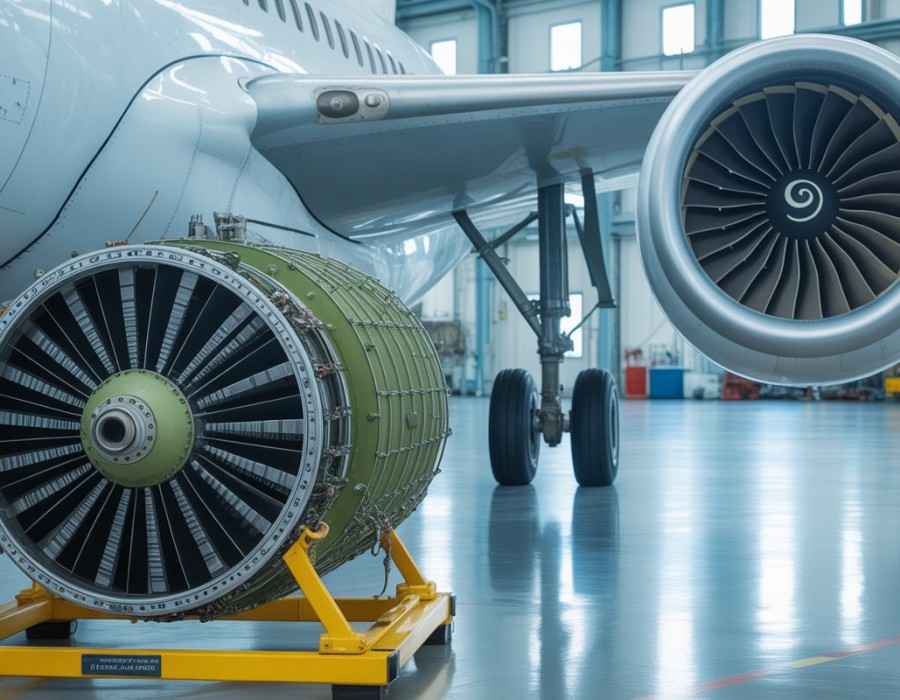In the fast-paced world of commercial aviation, ensuring aircraft safety and operational efficiency is paramount. One of the most critical ways operators achieve this is through aircraft component overhaul. Overhaul refers to a systematic process of inspecting, repairing, and refurbishing aircraft components to restore them to their original performance standards.
Beyond safety, these processes help airlines save on maintenance costs, extend the life of expensive components, and maintain uninterrupted flight operations. For fleet operators and maintenance teams, understanding the key considerations behind aircraft component overhaul is essential for making informed decisions.
Understanding Aircraft Component Overhaul
Airplane component overhaul is more than a simple repair. It involves a complete inspection and refurbishment process to return a component to “like-new” condition, often following strict manufacturer and regulatory standards.
Commonly overhauled components include starter generators, motors, relays, actuators, lighting systems, and more. Unlike a replacement, an aircraft component overhaul can be a cost-effective and environmentally responsible solution, reducing downtime while maximizing the usable life of critical aircraft parts.
Regulatory Compliance and Safety Standards
In aviation, safety and compliance are non-negotiable. Any aircraft component overhaul must meet rigorous FAA, EASA, and other regulatory authority requirements. Part 145 repair station standards, for example, ensure that overhauled components comply with strict quality and safety guidelines.
Proper documentation, traceability, and record-keeping are essential, not only for audits but also for ensuring that every overhauled part, including those undergoing aircraft starter generator repair, performs reliably in-flight. Non-compliance could result in safety risks, regulatory fines, and costly operational disruptions.
Selecting the Right Overhaul Provider
Choosing the right overhaul provider is critical for commercial aviation operators. The following factors should guide the decision-making process:
1. Experience and Expertise: Look for providers with extensive hands-on experience in overhauling commercial aircraft components. Providers with decades in the field are better equipped to handle complex systems and provide long-term reliability.
2. Certifications and Compliance: Ensure the provider is FAA-approved (Part 145) or EASA-certified, meeting all required regulatory standards. Certified providers guarantee that overhauled components, including aircraft terminal blocks, adhere to industry safety and performance norms.
3. Quality Assurance Practices: A trustworthy provider implements strict testing, inspection, and quality control procedures. This ensures every component leaving the workshop functions safely and efficiently.
4. Turnaround Time and Reliability: Minimizing aircraft downtime is crucial. Choose providers known for timely overhauls and consistent reliability, helping to maintain operational schedules.
5. Customer Support and Communication: Effective communication, progress updates, and technical support are essential throughout the aircraft component overhaul process, allowing operators to plan maintenance schedules confidently.
6. Access to Genuine or Approved Parts: Using FAA- or EASA-approved replacement parts is vital for safety and compliance. A reliable provider will source authentic parts for any replacements or upgrades.
Cost vs. Value in Aircraft Component Overhaul
One of the biggest considerations for operators is balancing cost with long-term value. While an outright replacement may seem faster, aircraft component overhaul programs often reduce overall maintenance expenses. By restoring existing components to peak performance, airlines can extend part lifecycles, reduce frequent replacements, and avoid unplanned operational interruptions.
Real-world examples show that overhauls of starter generators, motors, and other electromechanical components can save operators thousands of dollars over the lifespan of a fleet. The key is to weigh immediate costs against long-term operational and financial benefits.
Key Technical Considerations
A successful aircraft component overhaul requires careful attention to technical details. The following are the six most critical considerations:
1. Component Performance Standards
Every overhauled part, including aircraft electrical components, must meet or exceed the original manufacturer specifications. Maintaining these standards ensures that components function safely and efficiently under all operating conditions. Parts that fail to meet these benchmarks can compromise aircraft performance, affect system reliability, and increase the risk of in-flight failures.
2. Precision in Repair and Refurbishment
Aircraft components, particularly electromechanical and electrical systems, demand high levels of accuracy during overhaul. Even minor deviations in repair or refurbishment can result in functional errors, reduced component lifespan, or safety hazards. Precision workmanship is therefore essential to restoring components to their optimal condition.
3. Testing and Validation
Comprehensive testing is a cornerstone of effective aircraft component overhaul. Components must undergo functional, stress, and performance tests under conditions that closely simulate real-world operating environments. Validation ensures that each part will reliably perform when installed in the aircraft, minimizing the risk of failure and operational disruption.
4. Addressing Obsolescence
Overhaul programs must identify outdated or obsolete components, including those requiring aircraft starter generator repair, that are no longer supported by the manufacturer. These parts should be replaced or upgraded with approved alternatives to maintain compliance with regulatory standards and ensure continued operational efficiency.
5. Material Integrity
Every component must be inspected for wear, corrosion, fatigue, or other signs of degradation. Metals, wiring, and critical materials must be carefully evaluated and refurbished as necessary to prevent unexpected failures and maintain structural and functional integrity.
6. Compatibility with Aircraft Systems
Overhauled components must seamlessly integrate with existing aircraft systems, avionics, and subsystems. Improperly refurbished or incompatible parts can compromise system performance, interfere with avionics, and create potential safety risks. Ensuring full compatibility is essential for smooth and reliable aircraft operations.
Conclusion
In commercial aviation, aircraft component overhaul is more than a routine maintenance task, it is a strategic approach to fleet safety, reliability, and cost efficiency. By understanding the process, selecting the right overhaul provider, ensuring regulatory compliance, and focusing on technical considerations, operators can significantly enhance operational performance while reducing long-term expenses.
A well-executed overhaul program not only restores components to optimal performance but also protects the airline’s investment, reduces downtime, and ensures passengers’ safety. In an industry where reliability is non-negotiable, prioritizing professional, thorough aircraft component overhaul is a decision that benefits both the aircraft and the bottom line.
Partner with NAASCO for reliable, FAA-approved aircraft component overhaul. Reduce downtime, control costs, and maintain peak operational efficiency.
Request a quote today!





Comments